It was a bit like watching Abbott and Costello launch Apollo 11, witnessing the Kuva Coffee masterminds at work. Tim Drescher, co-founder and owner and his roastmaster Jim Colbert were hammering out the profile for the Jamaican Blue Mountain bean.
“We’re at 292 degrees and climbing fast,” Tim called from the helm. “296. 99. 305. 325! Oh, hey, 355”
“Jamaica’s in the funnel,” Jim called back, sounding a touch annoyed. He usually doesn’t have to deal with an audience. “We’re on standby and good to go.”
Less than a minute later, with the flick of a lever, an avalanche of straw colored coffee beans cascaded into the roasting drum. For a moment we crowded, transfixed, around the glass viewer as the beans tumbled rhythmically. For the longest time, they stayed the same pale hue.
“Hey, Jim, are you paying attention?” Tim called out suddenly, breaking the spell. The beans had just darkened to the color of dried grass. “Do we need to adjust the air flow? We’re at 40% and holding.”
Jim ignored this. He was busy adding to a column of numbers on a creased and worn sheet of notebook paper, and comparing it to a similar sheet that was taped to the work table. Without warning he stopped scribbling and leaned in, placing his ear close to the roaster.
“There goes first crack,” he said, almost to himself. “You hear it? Yeah, there it is. We’re cracking.” And we were. At once the sound of popping drowned out everything else.
“We just went up a level. Grass to toast. Cinnamon is on board next,” Tim said, referring to the color metamorphosis. “Jim, air flow check!”
But Jim was on it, and so shortly after enough moisture had been pulled out of the beans that they began to crackle, Jim emptied the beans into the cooling bin. This, the coveted Jamaican Blue Mountain, is a light roast. Extremely rare and highly prized, Kuva takes it just dark enough to highlight its “origin” flavors. In the cooling bin, the beans were stirred by a mechanical arm till they were able to be handled. As anyone who was standing before a pile of gold might be, I was tempted just then to shove my hands deep into the fragrant, shining beans. But that would have hurt. Still, I scooped one up and bit into it. The oils bit me back.
“That’s why we recommend you let the beans sit at least two days before you brew them,” Tim said, noting my surprise. “All those flavors have to settle back into the bean.” Kuva recommends letting the beans rest for a couple of days and then drinking them within six weeks. “This is when freshly roasted coffee is at its prime.”
At optimum freshness, this Jamaican Blue Mountain bean from the Mavis Bank plantation is a delicate balance of acidity, body, and flavor. Like some table wines, it’s an easy drinker, but it still packs in quite a it of complexity. It’s smooth, rich, mellow and bright, with a relatively low acidity.
What I was really there to see though was the roasting of the El Salvador El Jabali Bourbon. It is, dear reader, an heirloom coffee bean, and it was none too easy to find. Tim and Mike (Kuva’s other owner) were determined to track it down though. “I like a coffee challenge,” Tim once remarked to me, and apparently that’s no lie. But why is an heirloom java nugget such an elusive thing? For whatever reason, coffee beans have been aggressively hybridized, and even the single origin plantations use newer varieties. This El Salvador Bourbon bean is a real find.
Bourbon refers to the type of tree this coffee grows on. The El Salvador El Jabali comes from the Asocición Cooprativa de Producción Agropecuaria El Jabalí de S.R co-op. It’s a certified organic, fair trade bean, and Kuva is in the process of becoming a certified organic roaster (they’re already Rainforest Alliance certified), which makes this a bean you can be proud to brew. Of the 146 member farms that provide beans to the co-op, 12 of them are woman-owned. Jabali means wild boar, but don’t worry, this refers to the coffee’s untamed, unrefined growing habits rather than to flavor profile.
El Salvador Bourbon beans are roasted to second crack, which means it’s a deeper, fuller-bodied roast. Even a week after their roast date the oils glisten and shine. Kuva gives the bean a medium roast, bringing out the sweet, soft notes inherent in the bean. In the cup, the coffee has floral, citrusy hints with an undertone of chocolate.
Rich, full-bodied, chocolate – I don’t know about you, but that makes me think of cake. Before I launch into a recipe though, let me answer the burning question of where you can get Kuva Coffee for yourself. If you’re in St. Louis, you can pick it up at Local Harvest, Whole Foods, or this really cool café/shop/museum on Delmar called Winslow Home. And, while the season lasts you can it by the cup or by the pound at the Tower Grove Farmer’s Market. It’s also a great chance to meet Jim and Tim, as well as Mike Schlansker, Kuva’s co-owner. If you’re not local, you can order it directly from them online.
Cocoa and El Salvador Coffee Cake with Coffee Bean Brittle
Here’s a secret: I have a hard time making baked things look pretty. They don’t look the way I imagine the, not in real life and certainly not in photos, which can be even trickier You know how a bite of velvety cake looks decadent on a fork? In a photo it just looks like something someone has taken a bite of, with runny icing. See what I mean?
So my photos don’t make it look even half as lovely as it is. What if I tell you it was fit for a Sex in the City movie-viewing party last weekend (clearly we don’t deserve to call ourselves fans or we would have seen it in the theatre. We tried). I figured the rich mocha coffee bean cake could offer tribute to the girls’ patronage of Payards. So, after our homemade fried rice (in honor of Miranda’s habit) and our cosmos of course, we turned our attention to dessert. The cake was rich, velvety but not too sweet. Probably it’s best served in thinner slices; we all took hefty wedges, and I’m proud to say, reader, that we ate them, too.
If making a cake from scratch is just too much trouble, then you gotta make this coffee brittle. Now that we have parchment paper in the culinary world, it’s easy-peasy. Plus, the amber-spun confection glows like stained glass in the right light. But when you’re done playing with it and you actually bite into it, you just might find yourself hooked on the toasted, rich, chocolate-tinted stuff.
Cocoa and El Salvador Coffee Cake with Coffee Bean Brittle
1/3 cup cocoa powder
6 tablespoons unsalted butter
1/3 cup vegetable oil
2/3 cup El Salvador coffee, brewed strong
3 ounces dark chocolate, finely chopped
1 cup white sugar
1 large egg
2 teaspoons vanilla extract
1 1/4 cups all purpose flour
2 teaspoons baking powder
1/3 cup sour cream
Cream Topping:
1 ½ cups heavy cream, whipped
1 teaspoon vanilla extract
Coffee Bean Brittle
1 cup sugar
1/2 cup water
1 tablespoon roasted coffee beans, ground coarsely
Make coffee brittle first so that it has time to cool and harden. Begin by lining a large baking tray with parchment paper. In a small saucepan, heat sugar and water over high heat. Stir constantly until the sugar dissolves, then bring mixture to a boil. Don’t stir, letting the mixture change from a thin liquid into a thicker syrup.
When mixture changes into a light amber color (about 8 minutes), add the coffee beans and stir slightly to mix. Continue to cook the syrup till it turns golden brown. Remove from heat, pour the mixture into the prepared baking sheet, and then shake the tray slightly to spread syrup evenly. Allow brittle to cool, then peel away the parchment. Break into large shards. You can store this for several weeks, or for up to a year in the freezer.
To make the cake:
Preheat oven to 300 degrees F. Line the base of a 9 inch round cake pan with parchment paper (can you tell I love this stuff?). If possible, use a deep pan, about 3 inches. Dust the parchment with flour.
On stovetop, combine cocoa, butter, oil and coffee in a saucepan. Heat till butter melts then stir well. Bring to a boil and stir until the mixture becomes velvety.
Remove fro heat. Add the chocolate and sugar and stir well, until chocolate is completely melted and the mixture is rich and smooth. Allow the mixture to cool slightly, then add the egg and vanilla. Sift in the flour and baking powder and stir until just combined. Add the sour cream and stir gently.
Pour cake batter into the prepared pan and allow it to level out, then bake for about 45 minutes, or until a toothpick inserted into the center comes out clean. Let cool nd then invert the cake onto a rack.
Just before serving, spread the cream mixture on top, then sprinkle some of the coffee bean brittle over the cream.

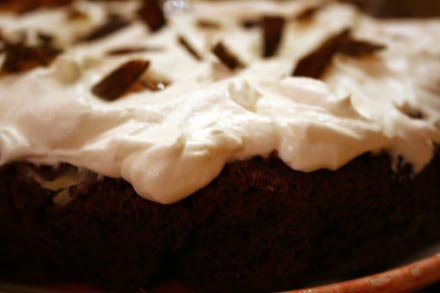
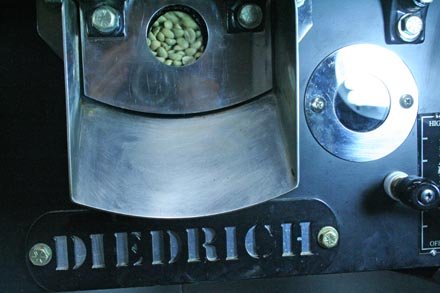
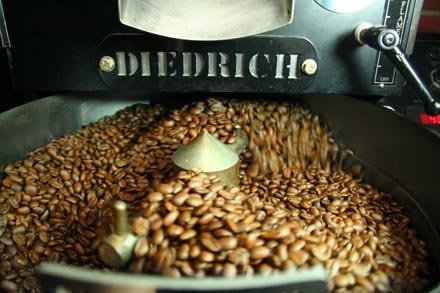
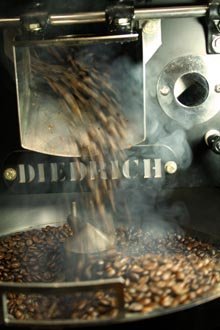
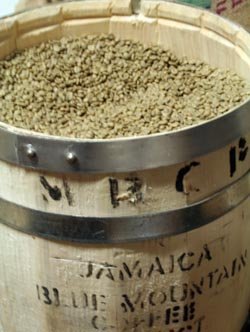
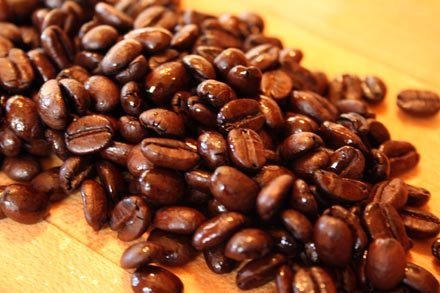
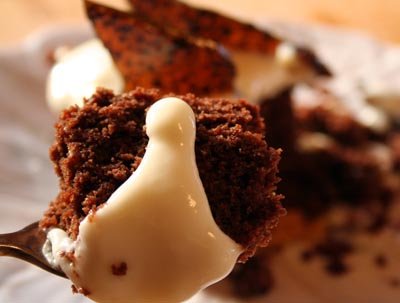
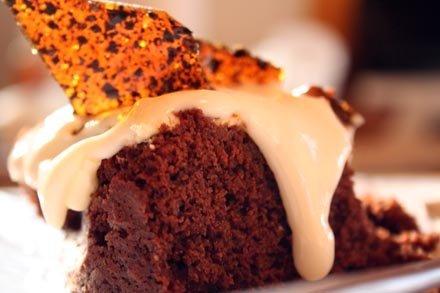
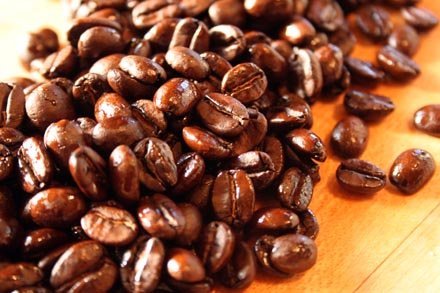
Oh, a new place to get coffee! Fabulous, I’m a huge fan. Except for Sumatra…we loved it until we found out what it’s doing to the tigers & other wildlife, & so now we refuse to buy it. I’m sure they’re feeling the pinch.
That recipe looks awesome!
The bite of cake on the fork looks quite decadent in your photo! As a fan of brittles, I’m definitely making this coffee version.
Ooh, I was wonering when you’d do coffee beans. I didn’ t realize they were such a rare commodity. I’m definiely going to have to get some from Kuva – but unfortunately I’m not in St. Louis, so I’ll have to have them shipped. Looking forward to trying the coffee bark.
I would think that most coffee would be heirloom, since some of these varieties are really old family plants? Is that not the case then? Either way, this looks delicious and I can’t wait to give it a try. It’s cold here today, good for baking
Claire: I think you could solve your Sumatra problem by buying Fair Traded coffee from there. I do. Two of my favourite coffees: Celebes Colossi and Sumatra Mandehling are both available Fair Traded, which means:
* The producer is paid a fair price which covers not only the costs of production but enables production which is socially just and environmentally sound.
* Helps develop a producer’s ability to remain independent.
* Helps provide a safe and healthy working environment for producers. Children are not to be exploited as cheap labourers.
* Women’s work is properly valued and rewarded.
* Encourages better environmental practices and responsible methods of production.
That sounds delicious! But we really need to get you some Kakao cocoa powder — it’s really rich and dark and better than anything I’ve seen. You’ll notice the difference.
And if you’re into brittle, maybe we could collaborate on some cocoa nib (the inside of the cocao BEAN) brittle for the holidays?
Very informative posts, and I love the look of you site.
a sex in the city fan
i knew i liked you
sounds really really really good…
really